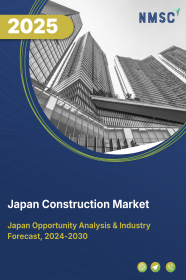
Japan Construction Market by Type (Renovation, and New Construction), by Construction Method (Traditional, Prefabricated/Modular, 3D-Printed, and Green/Sustainable), by Contractor Type (Large Contractor, Medium Contractor, and Small Contractor), and Sector (Real Estate, Commercial, Infrastructure, Industrial) – Industry Trends and Forecast, 2025–2030
Industry: Construction & Manufacturing | Publish Date: 09-Jun-2025 | No of Pages: 75 | No. of Tables: 87 | No. of Figures: 52 | Format: PDF | Report Code : CM2217
US Tariff Impact on Japan Construction Market
Trump Tariffs Are Reshaping Global Business
Japan Construction Industry Overview
The Japan Construction Market size was valued at USD 480.21 billion in 2024, and is projected to grow to USD 504.33 billion by 2025. Additionally, the industry is expected to continue its growth trajectory, reaching USD 571.43 billion by 2030, with a CAGR of 2.5% from 2025 to 2030.
The Japan construction market is experiencing substantial growth, driven by an increase in large-scale development projects and rising investments across key infrastructure sectors. These developments underscore the industry's pivotal role in supporting national economic progress.
At the same time, the market is undergoing a digital transformation, with the adoption of Building Information Modeling (BIM) and other advanced technologies enhancing project efficiency, collaboration, and lifecycle management.
Despite these positive trends, regulatory complexities continue to pose challenges by prolonging project timelines and increasing costs, yet the momentum toward modernization and digital integration signals strong potential for sustained expansion.
Significant Increase in Large-Scale Projects Drives the Japan Construction Market Growth
The construction sector in Japan is currently witnessing notable expansion, primarily driven by a surge in large-scale developments.
In 2024, major megaprojects such as the Higashigotanda Two Chome Third District Type One Urban Redevelopment, GLP Yachiyo V, Tenjin Business Center Phase 2 Project, Suzaka Refrigerated Showcase Manufacturing Factory, and the Kitanakadori North District B-1 District New Construction are playing a key role in propelling the industry forward. These initiatives emphasize the sector’s significant contribution to Japan’s economic development and its ongoing progress.
Escalating Investments Boosts the Japan Construction Market Trends
The expansion of the construction market in Japan is being strongly driven by rising investments in construction-related activities. According to data from the Global Infrastructure Hub, infrastructure investment in the construction sector reached USD 145 billion in 2024.
The road transport sector received the largest share at USD 53 billion, followed by the energy sector with USD 36 billion. This consistent investment momentum continues to push forward the growth and development of Japan’s infrastructure market.
Regulatory Complexities in the Infrastructure Market Barriers the Japan Construction Market Expansion
Navigating through regulatory complexities presents a formidable challenge in the construction market. Infrastructure projects often face hurdles due to the intricate network of government regulations and permitting procedures.
Infrastructure initiatives require obtaining numerous permits and approvals from governmental bodies at local, regional, and national levels. These mandates entail adherence to zoning regulations, environmental assessments, compliance with building codes, safety standards, and various regulatory requirements.
Lengthy permit acquisition processes, bureaucratic inefficiencies, and regulatory disparities among different jurisdictions can significantly extend project timelines and inflate costs. Moreover, fluctuations in regulations or unexpected policy changes can disrupt ongoing projects and deter potential investments.
Integration of Digitalization and BIM Presents Lucrative Opportunity for the Market Expansion
The construction sector is experiencing a major digital shift, largely fueled by the growing implementation of Building Information Modeling (BIM), which is creating new growth opportunities. BIM facilitates digital design, simulation, and infrastructure management, leading to greater accuracy, improved collaboration, and better resource utilization.
In line with this movement, ALLPLAN introduced Allplan 2024-1 in April 2024, enhancing BIM functionalities and optimizing cloud-based workflows highlighting the industry’s transition toward fully digital project delivery. Additionally, the integration of AI, IoT, and cloud technologies is advancing real-time collaboration, predictive maintenance, and streamlined facility management.
Competitive Landscape
The key players operating in the Japan construction industry include Obayashi Corporation, Kajima Corporation, Shimizu Corporation, Taisei Corporation, Takenaka Corporation, Haseko Corporation, Infroneer Holdings, Toda Corporation, Penta-Ocean Construction, Sumitomo Mitsui Construction, and others.
Japan Construction Market Key Segments
By Type
-
Renovation
-
New Construction
By Construction Method
-
Traditional Construction
-
Prefabricated/Modular Construction
-
3D-Printed Construction
-
Green/Sustainable Construction
By Type of Contractor
-
Large Contractor
-
Medium Contractor
-
Small Contractor
By Sector
-
Real Estate
-
Residential
-
Affordable
-
Luxury
-
-
Commercial
-
Retail Buildings
-
Office Buildings
-
Hospitality
-
Healthcare Facilities
-
Educational Institutes
-
Entertainment Ventures
-
-
-
Infrastructure
-
Transportation
-
Airport
-
Port
-
Rail
-
Road
-
-
Water and Wastewater
-
Energy
-
Telecommunication
-
-
Industrial
-
Manufacturing Plant
-
Warehouses
-
Power Plants
-
Oil Refineries
-
Chemical Plants
-
Key Players
-
Obayashi Corporation
-
Kajima Corporation
-
Shimizu Corporation
-
Taisei Corporation
-
Takenaka Corporation
-
Haseko Corporation
-
Infroneer Holdings
-
Toda Corporation
-
Penta-Ocean Construction
-
Sumitomo Mitsui Construction
REPORT SCOPE AND SEGMENTATION:
|
Parameters |
Details |
|
Market Size in 2024 |
USD 480.21 Billion |
|
Revenue Forecast in 2030 |
USD 571.43 Billion |
|
Growth Rate |
CAGR of 2.5% from 2025 to 2030 |
|
Analysis Period |
2024–2030 |
|
Base Year Considered |
2024 |
|
Forecast Period |
2025–2030 |
|
Market Size Estimation |
Billion (USD) |
|
Growth Factors |
|
|
Companies Profiled |
10 |
|
Market Share |
Available for 10 companies |
|
Customization Scope |
Free customization (equivalent up to 80 working hours of analysts) after purchase. Addition or alteration to country, regional, and segment scope. |
|
Pricing and Purchase Options |
Avail customized purchase options to meet your exact research needs. |

















 Speak to Our Analyst
Speak to Our Analyst

















